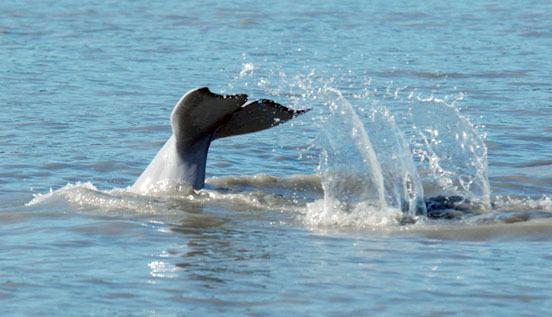
The beluga whale population in Cook Inlet has been steadily declining since the 1970s.
The number of whales in the area today is just a third of what it once was, and the Alaska Department of Fish Game wants to help belugas recover.
In order to do that, Fish and Game needs to answer other questions about mating and their habitat, and two new studies aim to do just that.
Back in the 1970s, beluga whales were common around Cook Inlet, with a count of about 1,300 in the area. Now that number is closer to 340.
Cook Inlet belugas were officially listed as endangered in 2008, and things have not gotten better.
Cook Inlet itself was listed as critical habitat in 2011.
Two new Fish and Game studies aim to find out more about where belugas feed and their social behaviors.
“Both of these studies have been based on samples and research that have been going on for ten years or more,” Fish and Game wildlife physiologist Mandy Keough said.
Keough samples teeth found in stranded belugas in order to get a better idea about their feeding habits.
“One of the reasons why both these proposals have been funded is that we are finally at a point where we have enough samples and enough collaborators with various expertise working together to be able to address these questions,” Keough said.
Fish and Game hopes both past data and new samples help find where Cook Inlet belugas have fed in the past and if feeding grounds have shifted.
Fish and Game anchored audio recording devices to track where whales are finding food.
“Looking for that acoustic signature, that whistle that they make. It’s actually a buzz that signifies that they have had a successful forage,” Keough said.
After they locate where these sounds are coming from, people can go to the sites and research further.
The second half of the project focuses on belugas in Bristol Bay.
Fish and Game thinks that population could give some insight into the mating habits for whales back in Cook Inlet.
Lori Quakenbush heads up that study and works for the Fish and Game Mammal Program.
Over in Bristol Bay, the beluga whale count is double Cook Inlet’s numbers.
More beluga whales means a larger dataset to pull information.
Using skin samples from Bristol Bay whales, researchers can see how the whales are related, giving them an idea of which whales are mating.
Quakenbush thinks belugas might have a pack mentality, almost like wolves.
“You might have 10 adult males and 10 adult females in any given years,” Quakenbush said. “It may only be one or two of them mating and reproducing as opposed to all of them.”
Quakenbush wants to use the data to inform best practices for increasing the population in Cook Inlet.
While Quakenbush hopes to come up with a strong game plan, she notes the answer may be inconvenient.
“We will investigate that large genetic dataset that we have and see what we can learn about belugas overall,” Quakenbush said. “That might affect how quickly a population like Cook Inlet can expand. It might be very different than what we’re thinking,”
So, where are the Cook Inlet whales now? The belugas mostly stay in Upper Cook Inlet.
However, there is not substantial research as to why. Keough said that is another goal of the project.
“We don’t know if that’s just because there are fewer animals available, or if they are relying on more fresh water fish than they have historically,” Keough said.
After the study, Fish and Game hopes to have more answers than questions, and that those answers will lead to more belugas in Cook Inlet.




